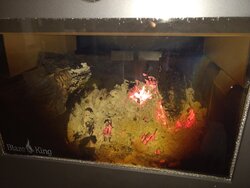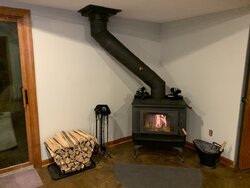@Poindexter yes, I insulated a lot (sealed all the seems in the attic and added insulation there to R58). Outlets are caulked (inside and the rim), and I put the foam thingies under the plates as well. And new (triple pane) windows recently. Wall insulation could be better though (after having a piece of drywall off and replacing the insulation, I can feel the difference on the drywall... - but it does not make economic sense to do that other than when the wall is open for other reasons).
Okay, I'll change how I describe the tstat setting. For me 12 o'clock is the minimum of the swoosh (though the knob can go "down" further, all the way back to 8 o'clock or so), and 6 o'clock is the maximum of the swoosh (hard stop).
*When you talk about fractions that's fractions of the swoosh (12-6 for me) or the full range of motion (8-6 for me)?*
I think I'll scoop ashes out rather than use the drawer. I have a metal bucket with a lid, and can walk out of my basement into the garage onto the driveway. I don't think I'll leave them in the drawer; maybe all goes well with CO, but I prefer not to take that risk. (Yes I have 2 CO detectors and 2 smoke detectors at appropriate places in the basement, and one on each floor above that. )
The reload yesterday went well; shoveled coals into a full line in the front, and relighting was even. In fact, already after 12 minutes all was on fire, all black, and showing new cracks. So I throttled down quite before the 20-30 minutes.
Went even slightly lower on the tstat to see how long I could go. This morning (17 hrs in) the home was a bit cold (65) b/c it had cooled down more (29 outside). Cat probe was at 1/5 of the active range and quite some glowing coals and charred pieces left.
I increased the tstat to 1/2 swoosh, to get more heat. I think it would have gone on until at least 22 hrs runtime if I had not done that. However, I think increasing the tstat increased the airflow without (initially?) creating more gases, so the cat cooled down to the border of the active range. B/c I wanted a short heat boost (later today the heatpump will take over) and the 1/2 swoosh setting did not deliver (fast enough?), I opened and added a few uglies that don't stack well in a full load.
I note that I did again get some smoke inside (after putting down the first new pieces that started to smoke almost immediately) despite letting it sit on max and w/ the bypass open for a few mins before I cracked the door. I wonder if that is b/c the chimney is too cold already for a proper draft?
I like the idea of 2 small splits E/W behind a line of coals and the rest N/S. Will try that next time I do a big hot reload (given the weather predictions that might be more than a week from now... :-( ).
@kennyp2339
Yes, I noticed the stages; I got secondaries on my second break-in burn. Goes well with some Pink Floyd

But other than a short time during the transition from rage to low-and-long I have not been there; I did reach stage 3 quite fast yesterday after the reload, likely because I throttled down far and fairly fast.
My wood seems to be good for that so far. Maybe my splits are a bit too small (I had a long (22") but very narrow, or better, wide and not very deep firebox earlier, so smaller splits allowed me to stack more in there). I saw
@BKVP's mention of 8" pieces and have seen some pics around here. Ah well, over the course of 2-3 yrs I'll slowly get to burn bigger pieces.
I have not seen the candle-like flames yet. In the end, I have to find the right setting for the weather. This past night I ran a bit too low for the desired house T given the weather (though a higher setting might have used up all the fuel before the morning started for me, given the midday reload yesterday...). The issue with playing and learning here is that there are (at least) two variables that keep changing simultaneously: weather and my settings, making the learning curve a bit jumpy and uncertain.
ok. That's it for now.





 , so time is not the issue. Thanks for the details on the process. Sounds good for when I have to leave home indeed.
, so time is not the issue. Thanks for the details on the process. Sounds good for when I have to leave home indeed.

 But other than a short time during the transition from rage to low-and-long I have not been there; I did reach stage 3 quite fast yesterday after the reload, likely because I throttled down far and fairly fast.
But other than a short time during the transition from rage to low-and-long I have not been there; I did reach stage 3 quite fast yesterday after the reload, likely because I throttled down far and fairly fast.